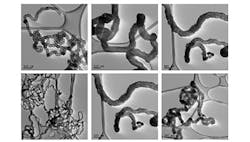Method Upcycles Two Major Wastes
Researchers at RMIT University, Melbourne, Australia, say they have developed a method to produce contaminant-free fuel and carbon nanotubes (CNTs) from discarded plastic using organic waste to make the necessary biocatalyst. Upcycling two massive waste streams through one circular economy approach could deliver significant financial and environmental benefits, suggests lead researcher Kalpit Shah. “Our method is clean, cost-effective and readily scaleable,” he adds.
CNTs can be used for many applications in a range of sectors including hydrogen storage, composite materials, electronics, fuel cells and biomedical technologies. They also are in growing demand, particularly in aerospace and defense, where they can facilitate the design of lightweight parts.
However, CNTs typically are produced via a thermal chemical vapor deposition (CVD) process that is difficult to scale up. Moreover, the process, which operates at extremely high temperatures, is highly endothermic and, so, requires a significant amount of energy to sustain the necessary temperature.
In the researchers’ new two-step CVD process, the team first converts organic waste such as agricultural residue into a carbon-rich and high-value form of charcoal, called biochar, and then uses it as a catalyst to upcycle the plastic.
The biochar nanoparticles significantly reduce the presence of contaminants such as polycyclic aromatic hydrocarbons, as the waste plastic is broken down to become high-quality, clean liquid fuel. At the same time, the carbon in the plastic is converted to CNTs, which coat the biochar.
The nano-sized biochar exhibited higher growth of CNTs with better quality due to their strong gas/solid contact and void fraction, which enhanced the diffusion-precipitation mechanism, say the researchers in a recent article in the Journal of Environmental Management.
The researchers also found the growth rate of CNTs increased with reaction temperature at 900°C as a result of faster carbon diffusion through the catalyst particle, leading to larger CNT production. While the new process would cut the cost to produce CNTs, the resultant CNTs might have a less homogeneous structure than those from conventional CVD production, they caution.
Adding to the circular economy approach, the nano-carbon-enhanced biochar can be used directly for environmental remediation and boosting agricultural soils.
The study focused on polypropylene but the approach would be applicable to a range of plastic types, the researchers believe.
We have already started investigating polyethylene and polyvinyl chloride plastics as well as the mixture of other plastics in our two-stage CVD process for producing carbon nanotube, says Shah.
“While we need to do further research to test different plastics, as the quality of the fuel produced will vary, the method we’ve developed is generally suitable for upcycling any polymers — the base ingredients for all plastic,” he adds.
The researchers believe their method can be replicated in a reactor based on fluidized bed technology, and offers significant improvement in heat and mass transfer compared to CVD, reducing overall capital and operating costs.
The team has successfully conducted lab-scale trials; the next step is to demonstrate the CVD process in their reactor at a pilot-scale.
A few multinational companies have contacted Shah’s team about possible collaboration for further experimental, modeling and pilot-plant trials.
